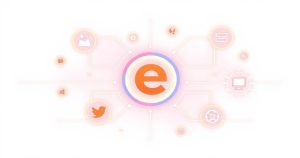As an Etsy seller, your focus should be on creating unique products and building a strong brand. However, the daily administrative tasks of running a shop can quickly become overwhelming. Managing orders, handling shipping, marketing your items, and tracking finances consume valuable time. This is where Etsy integrations come in. These powerful third-party tools are designed to connect with your shop, automate repetitive processes, and provide new functionalities that streamline your entire operation, allowing you to focus on growth and creativity.
What Are Etsy Integrations?
Etsy integrations are specialized software applications that connect to your Etsy shop through its Application Programming Interface (API). This connection allows the app to securely access your shop’s data—such as orders, listings, and customer information—to perform specific functions automatically. Think of them as assistants that work for you around the clock. From automatically printing shipping labels to posting your new listings on social media, these tools handle essential tasks that would otherwise require significant manual effort and time.
Why You Need Etsy Integrations for Growth
Integrating third-party tools is no longer a luxury but a necessity for serious sellers aiming to scale their business. The primary benefit is a massive increase in efficiency. By automating key workflows, you free up hours each week. This reclaimed time can be reinvested into product development, customer service, or strategic planning. Furthermore, professional integrations often lead to fewer errors, improved accuracy in order fulfillment and accounting, and a more polished experience for your customers, building trust and encouraging repeat business.
1. Saving Time Through Automation
The most immediate impact of using Etsy integrations is time savings. Imagine a system that automatically sends order details to your shipping provider, updates inventory levels across multiple platforms, and schedules your promotional posts for the entire week. These automated workflows eliminate the need for manual data entry and repetitive clicking. This efficiency is crucial as your order volume grows, preventing you from becoming a bottleneck in your own business and ensuring smooth operations during busy seasons.
2. Expanding Your Product Offerings Effortlessly
Perhaps one of the most transformative types of Etsy integrations is print-on-demand (POD). Services like Printful or Printify allow you to sell a wide range of custom products, such as t-shirts, mugs, posters, and phone cases, without holding any physical inventory. When a customer places an order, the integration automatically sends it to the POD provider, who then prints, packages, and ships the item directly to your customer. This model minimizes financial risk and logistical headaches.
3. Enhancing the Customer Experience
A positive customer experience is vital for securing good reviews and fostering loyalty. Shipping and fulfillment integrations play a key role here. They can automatically send tracking information to customers, offer more reliable shipping estimates, and provide access to discounted shipping rates that you can pass on. Similarly, marketing integrations that manage email newsletters help you build a community around your brand, keeping customers engaged with updates, promotions, and new product announcements long after their initial purchase.
Top Categories of Etsy Integrations
The world of Etsy integrations is vast, with tools designed to solve nearly every challenge a seller might face. Understanding the main categories helps you identify which solutions will have the greatest impact on your specific business needs. Focusing on your biggest pain points first—whether it’s shipping, marketing, or finances—is the most effective way to start leveraging these powerful applications. Most successful shops use a combination of tools from several of these categories to create a highly efficient, automated ecosystem.
1. Print-on-Demand (POD) Services
Print-on-demand integrations are a game-changer for artists, designers, and entrepreneurs. By connecting your Etsy shop to a platform like Printify or Printful, you can upload your designs onto a catalog of hundreds of products. There are no upfront costs for inventory. You only pay for the product after you’ve made a sale. This business model allows for immense creative freedom and scalability, enabling you to test new designs and product lines with zero risk and minimal investment.
2. Shipping and Fulfillment Solutions
As orders increase, shipping can become a major time sink. Shipping integrations like ShipStation, Pirate Ship, or Shippo are essential for managing this process. These platforms import your Etsy orders automatically, allowing you to compare carrier rates, purchase postage at a discount, and print shipping labels in bulk. This centralization saves countless hours and reduces the chance of errors, ensuring that packages get to your customers quickly and affordably. Many also handle international customs forms seamlessly.
3. Marketing and Social Media Automation
Promoting your products is key to driving traffic and sales. Marketing integrations help automate this crucial task. Tools like Outfy or Vela can automatically create and schedule social media posts for your new listings or existing products across platforms like Instagram, Pinterest, and Facebook. Email marketing integrations, such as those for Mailchimp or AWeber, help you capture customer emails and build mailing lists for newsletters and promotional campaigns, turning one-time buyers into loyal fans.
4. Accounting and Bookkeeping Tools
Proper financial management is critical for understanding your shop’s profitability. Accounting integrations like QuickBooks Self-Employed, GoDaddy Bookkeeping, or Paper + Spark connect directly to your Etsy account to import all sales and fee data automatically. These tools categorize your income and expenses, calculate profit margins, and make tax preparation significantly simpler. By providing a clear overview of your finances, they empower you to make smarter business decisions based on accurate data rather than guesswork.
5. Inventory and Order Management
For sellers who operate on multiple platforms—such as Etsy, Shopify, and Amazon—managing inventory can be a complex challenge. An inventory management integration is the solution. These systems act as a central hub, syncing your stock levels across all channels in real time. When an item sells on Etsy, its quantity is automatically updated on your Shopify store, and vice-versa. This prevents overselling and ensures a consistent, professional experience for all your customers, regardless of where they shop.
How to Choose the Right Etsy Integration
With so many options available, selecting the right integration requires careful consideration. The first step is to clearly identify your biggest challenge. Are you spending too much time packing orders? Is your social media presence non-existent? Or are your finances a mess? Pinpointing your primary pain point will guide you toward the category of tool that will provide the most immediate benefit. Start with one problem and find the best solution for it before expanding to other areas.
Next, evaluate the cost structure and user reviews. Many integrations offer a free trial or a free basic plan, allowing you to test the service before committing. Paid plans often operate on a monthly subscription model, which can range from $10 to over $100 depending on the features and your sales volume. Always read recent reviews from other Etsy sellers to understand the tool’s reliability, ease of use, and quality of customer support. A cheap tool with poor support can create more problems than it solves.
Conclusion: Building a More Resilient Business
Etsy integrations are more than just convenient add-ons; they are strategic assets that empower you to build a more efficient, scalable, and professional business. By automating the administrative burdens of e-commerce, you unlock the time and mental space needed to focus on what truly matters: creating exceptional products and connecting with your customers. By carefully selecting and implementing the right tools, you can streamline your operations, reduce stress, and position your Etsy shop for sustainable long-term growth and success.





